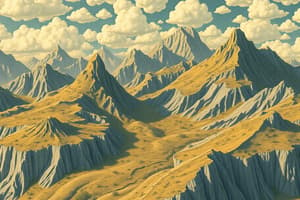Podcast
Questions and Answers
Los landforms se refieren a las características naturales en la superficie de la Tierra, como montañas y mesetas.
Los landforms se refieren a las características naturales en la superficie de la Tierra, como montañas y mesetas.
True (A)
La erosión es un proceso geomorfológico que implica la acumulación de sedimentos.
La erosión es un proceso geomorfológico que implica la acumulación de sedimentos.
False (B)
La deposición es el movimiento de materiales de un lugar a otro, impulsado por el agua, el viento o el hielo.
La deposición es el movimiento de materiales de un lugar a otro, impulsado por el agua, el viento o el hielo.
False (B)
El desgaste de rocas y suelos en fragmentos más pequeños se conoce como erosión.
El desgaste de rocas y suelos en fragmentos más pequeños se conoce como erosión.
Los procesos geomorfológicos son las fuerzas que crean y modifican los landforms.
Los procesos geomorfológicos son las fuerzas que crean y modifican los landforms.
La meteorización prepara las rocas y suelos para la erosión y la deposición.
La meteorización prepara las rocas y suelos para la erosión y la deposición.
El equilibrio __________ describe una condición en un sistema donde la distribución de masa y energía se mueve hacia la máxima entropía.
El equilibrio __________ describe una condición en un sistema donde la distribución de masa y energía se mueve hacia la máxima entropía.
El equilibrio __________ ocurre cuando hay estados promedio no repetidos a lo largo del tiempo.
El equilibrio __________ ocurre cuando hay estados promedio no repetidos a lo largo del tiempo.
El equilibrio __________ está donde la fuerza y la reacción están balanceadas y las propiedades del sistema permanecen invariables a lo largo del tiempo.
El equilibrio __________ está donde la fuerza y la reacción están balanceadas y las propiedades del sistema permanecen invariables a lo largo del tiempo.
En un equilibrio __________ el sistema muestra tendencias de regresar al mismo equilibrio después de una perturbación.
En un equilibrio __________ el sistema muestra tendencias de regresar al mismo equilibrio después de una perturbación.
En un equilibrio __________ el sistema regresa a un nuevo equilibrio después de una perturbación.
En un equilibrio __________ el sistema regresa a un nuevo equilibrio después de una perturbación.
Los mecanismos de ______ controlan el estado del sistema al amortiguar o reducir el tamaño de los elementos o atributos del sistema.
Los mecanismos de ______ controlan el estado del sistema al amortiguar o reducir el tamaño de los elementos o atributos del sistema.
La ______ ocurre cuando el estado del sistema de un organismo depende no solo de un estímulo original, sino también de los resultados de su estado previo.
La ______ ocurre cuando el estado del sistema de un organismo depende no solo de un estímulo original, sino también de los resultados de su estado previo.
Un feedback positivo causa un cambio autosostenido que aumenta el estado de un ______.
Un feedback positivo causa un cambio autosostenido que aumenta el estado de un ______.
La presencia de mecanismos de retroalimentación negativa y positiva en un sistema resulta en la ______.
La presencia de mecanismos de retroalimentación negativa y positiva en un sistema resulta en la ______.
El tamaño de la población en relación con el suministro de alimentos produce una ______ negativa a medida que la fertilidad de los áfidos comienza a disminuir.
El tamaño de la población en relación con el suministro de alimentos produce una ______ negativa a medida que la fertilidad de los áfidos comienza a disminuir.
Study Notes
Geomorphology: Landforms, Geomorphic Processes, Weathering
Geomorphology is the scientific study of the origin and evolution of topographic and bathymetric elements, such as hills, valleys, and coastlines, through physical or chemical processes at or near the Earth's surface. It encompasses several key aspects, including landforms, geomorphic processes, and weathering.
Landforms
Landforms refer to natural features on the Earth's surface, ranging from minor irregularities to major landmasses like mountains and plateaus. They are shaped by various combinations of tectonic, volcanic, glacial, fluvial, coastal, wind, and mass movement processes acting upon rocks and soils. Examples of landforms include deltas, gorges, mesas, and buttes.
Geomorphic Processes
Geomorphic processes are the forces that create and modify landforms. Some of the primary processes include:
- Erosion: The wearing away of the Earth's surface by agents such as water (e.g., rivers), wind, or ice (e.g., glaciers).
- Deposition: The accumulation of sediments, such as by river or wind action, or by the fallout of volcanic ash.
- Transportation: The movement of materials from one place to another, such as by water, wind, or ice.
- Weathering: The breaking down of rocks and soils into smaller fragments by physical, chemical, and biological processes.
Weathering
Weathering is a critical component of geomorphology, as it prepares rocks and soils for erosion and deposition. There are two main types of weathering:
- Physical Weathering: This occurs when rocks and soils are broken down by mechanical forces such as freezing and thawing, the expansion and contraction of clay minerals, or impact by stones and ice.
- Chemical Weathering: This involves the breakdown of rocks and soils through chemical reactions, such as the dissolution of minerals by water or the oxidation of iron in the presence of oxygen.
In summary, geomorphology is a multidisciplinary field that examines the Earth's surface features and the processes that shape them. Understanding landforms, geomorphic processes, and weathering is essential for comprehending how the Earth evolves and responds to environmental changes.
Studying That Suits You
Use AI to generate personalized quizzes and flashcards to suit your learning preferences.
Description
Learn about the study of topographic and bathymetric elements, including landforms, geomorphic processes, and weathering in geomorphology. Explore how natural features are shaped by tectonic, volcanic, glacial, and other processes, and the forces that create and modify landforms through erosion, deposition, transportation, and weathering.




